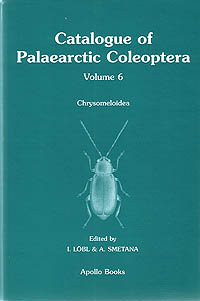Welcome to the
website of the Granivorous Insect Study Team!
| BRUCHINEWS If you have new paper or useful information, news please contact with me. |
Last
updated: 04.01.2012
New Bruchinae paper by Kergoat and his colleague
Condamine, F.L., Sperling, F.A.H., Wahlberg, N., Rasplus, J.-Y. & Kergoat, G.J. 2012. What causes latitudinal gradients in species diversity? Evolutionary processes and ecological constraints on swallowtail biodiversity. Ecology Letters. accepted. IF2010=15.253
ANELIA M. STOJANOVA,
ZOLTAN GYÖRGY, ZOLTÁN LÁSZLÓ
(2011): A New Seed Beetle Species to the
Bulgarian Fauna: Bruchidius siliquastri, Delobel
(Coleoptera: Chrysomelidae: Bruchinae),
pp. 117-119 Article № eb.11205 
ABSTRACT

ABSTRACT
A seed beetle Bruchidius
siliquastri DELOBEL, 2007 (Coleoptera: Chrysomelidae) was reared from ripe pods of Cercis
siliquastrum (Fabaceae) in Bulgaria and this is the first record of the
species to
the Bulgarian fauna. New host plants of the bruchid species were
established on the basis of material collected in Hungary:
Cercis occidentalis, Cercis chinensis and Cercis griffithii. A rich hymenopteran complex associated
with the seed beetle was reared and comments on it are presented. Key words: Bruchidius
siliquastri, Bruchinae, Hymenoptera, Bulgaria, Hungary, new
associations.
New Bruchinae paper by Gaël J. Kergoat
P18. Kergoat, G.J.,
Le Ru, B.P., Genson, G., Cruaud, C., Couloux, A. & Delobel, A.
2011. Phylogenetics, species boundaries and timing of resource tracking
in a highly specialized group of seed beetles (Coleoptera:
Chrysomelidae: Bruchinae). Molecular Phylogenetics and
Evolution. 59: 746-760. IF2009=3.556 

ABSTRACT
Though for a long time
it was
hypothesized that the extraordinary diversity of phytophagous insects
was better explained by a synchronous pattern of co-diversification
with plants, the results of recent studies have led to question this
theory, suggesting that the diversification of insects occurred well
after that of their hosts. In this study we address this issue by
investigating the timing of diversification of a highly specialized
group of seed beetles, which mostly feeds on legume plants from the
tribe Indigofereae. To that purpose, a total of 130 specimens were
sequenced for six genes and analyzed under a Bayesian phylogenetic
framework. Based on the resulting trees we performed several analyses
that allowed a better definition of the group boundaries and to
investigate the status of several taxa through the use of molecular
species delimitation analyses in combination with morphological
evidences. In addition the evolution of host plant use was
reconstructed and different molecular-dating approaches were carried
out in order to assess the ages of several clades of interest. The
resulting framework suggests a more ancient than previously thought
origin for seed beetles, and a pattern of rapid host plant
colonization. These findings call for further similar studies in other
highly specialized groups of phytophagous insects.
New book! Catalogueof Palearctic Coleoptera volume 6
 I
Löbl and A. Smetana had edited the sixth series
Chrysomeloidea.This is important to us in the known seed beetle
Klaus-Werner Anton wrote. The expert, unfortunately, not every species
has clarified the issues, and several species synonimised.
Unfortunately, the Hungarian bruchids of the study is incomplete. Seems
that in 2005, he is not studied in greater depth the appeared
checklist, so the sign under the HU data is likely to come from their
database.
I
Löbl and A. Smetana had edited the sixth series
Chrysomeloidea.This is important to us in the known seed beetle
Klaus-Werner Anton wrote. The expert, unfortunately, not every species
has clarified the issues, and several species synonimised.
Unfortunately, the Hungarian bruchids of the study is incomplete. Seems
that in 2005, he is not studied in greater depth the appeared
checklist, so the sign under the HU data is likely to come from their
database.The original checklist of Hungary

New invasive bruchid species from Bulgaria (2010)
SEED BEETLE BRUCHIDIUS TERRENUS (SHARP) (COLEOPTERA: CHRYSOMELIDAE: BRUCHINAE) - NEW INVASIVE SPECIES TO THE BULGARIAN FAUNA
AUTHOR
Anelia Stojanova
University of Plovdiv, Department of Zoology, Plovdiv, Bulgaria E-mail: stanelia@uni-plovdiv.bg
ABSTRACT
The East Palaearctic seed beetle Bruchidius terrenus (Coleoptera: Chrysomelidae: Bruchinae) is recorded for the first time to the Bulgarian fauna. Larvae of the bruchid infest mature seeds of introduced mimosa Albizia julibrissin (Fabacea), an ornamental tree in many countries. The level of damage on seeds caused by bruchid larvae was examined.

New seed beetle in Hungary (previous news 2002)
Adults of Megabruchidius
tonkineus
(Pic, 1904) emerged in the laboratory from pods of Gleditsia
triacanthos collected in January and in October 2001 at the very centre
of Budapest. It is likely that this tropical species is able to
over-winter outdoors at least in urban surroundings of Hungary. The
possible economic importance is discusssed:
Jermy, T., Szentesi, Á. & Anton, K.-W. (2002): Megabruchidius tonkineus (Pic, 1904) (Coleoptera: Bruchidae) first found in Hungary. Folia Entomol. Hung., 63: 49-51.
Biologycal information discussed:
György, Z (2007): To the biology of the honey locust seed beetle, Megabruchidius tonkineus (Pic, 1904) (Coleoptera: Chrysomelidae: Bruchinae) – Folia Entomologica Hungarica 68: 89–96.
Jermy, T., Szentesi, Á. & Anton, K.-W. (2002): Megabruchidius tonkineus (Pic, 1904) (Coleoptera: Bruchidae) first found in Hungary. Folia Entomol. Hung., 63: 49-51.

Biologycal information discussed:
György, Z (2007): To the biology of the honey locust seed beetle, Megabruchidius tonkineus (Pic, 1904) (Coleoptera: Chrysomelidae: Bruchinae) – Folia Entomologica Hungarica 68: 89–96.

The e-bean
PADIL
Useful Bruchid seed beetle pictures on the website of Pest and Diseases
Image Library >>>>>>>Fauna Europae
List of the European
seed beetles.
Audisio, Prof. Paolo (group coordinator), Zampetti, Mr. Marcello Franco
(taxonomic specialist) >>>>>>>
Bruchidae collection of Siberian
Zoological Museum (curator - Andrei A. Legalov)
Andrei A. Legalov added a list of the materials. >>>>>>>
Dr.
Clarence Dan Johnson died March 28, 2005 at age 74.
 Dr.
Clarence Dan Johnson of Flagstaff, Arizona died of acute leukemia on
March 28, 2005 at age 74. He was born July 20, 1931 in Exeter,
California and received his primary schooling in Tulare, California. He
received his MS degree from Arizona State University, Tempe in 1961,
and his PhD in Entomology from University of California, Berkeley in
1966. After serving in the U.S. Army from 1954 to 1956, he taught
science in Fresno, California, schools 1956-1963.
Dr.
Clarence Dan Johnson of Flagstaff, Arizona died of acute leukemia on
March 28, 2005 at age 74. He was born July 20, 1931 in Exeter,
California and received his primary schooling in Tulare, California. He
received his MS degree from Arizona State University, Tempe in 1961,
and his PhD in Entomology from University of California, Berkeley in
1966. After serving in the U.S. Army from 1954 to 1956, he taught
science in Fresno, California, schools 1956-1963.In 1966, he joined the faculty of Northern Arizona University at Flagstaff as assistant professor, became an associate professor in 1970 and served as a full professor from 1976 until his retirement in 1994. He was a world authority on the classification of the beetle family Bruchidae, especially in their associations with host plants. Most of his students chose as their thesis subjects some aspect of bruchid taxonomy or their life history, and many of his more than 175 papers were in collaboration with students, or with colleagues. His numerous collecting trips in western United States, Mexico, Central America and northern South America provided study material for him and his students, and his colleagues. He was still publishing papers in 2005. His extensive collection of Bruchidae is now deposited in the arthropod collection of Texas A & M University, College Station.
Dr. Johnson was a member of the Coleopterists Society, Sigma Xi, Pacific Coast Entomological Society, the Kansas Entomological Society, the Society of Systematic Zoology, Society for the Study of Evolution, the Ecological Society of America, the Society for Tropical Biology, the Arizona-Nevada Academy of Science and member of the International Advisory Board of the Revista Brasileira de Entomologia. He was a recipient of several academic awards and research grants, and participated in a number of international symposia and conferences on Bruchidae. In his position at Northern Arizona University, he was a member of numerous faculty committees as well as committees in national and international societies.
He leaves behind his wife Margaret and four children and their families.
John M. Kingsolver
Cibele S. Ribeiro-Costa
Reference: Revista Brasileira de Entomologia
Print version ISSN 0085-5626
Rev. Bras. entomol. vol.49 no.2 Săo Paulo June 2005

Copyright
© 2009. Hungarian Natural History Museum, Department of
Zoology, Coleoptera Collection
webmaster: György, Zoltán
webmaster: György, Zoltán


